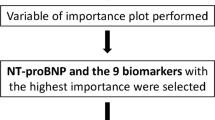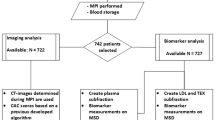Abstract
Long-chain fatty acids (LCFA) are one of the major cardiac energy substrates, so understanding LCFA metabolism may help in elucidating the mechanisms of various heart diseases. CD36 is a multifunctional membrane glycoprotein that acts not only as a receptor for thrombospondin, collagen and oxidized low density lipoprotein but also as a receptor for LCFA. We investigated the relationship between CD36 expression in myocardial capillary endothelial cells and myocardial LCFA uptake in patients with CD36 deficiency. We analyzed CD36 expression in blood cells from 250 patients with heart diseases by means of a flow cytometer. In 218 patients, myocardial LCFA scintigraphy was performed with123I-β-methyl-p-iodophenyl pentadecanoic acid (BMIPP). In 5 patients, myocardial capillary endothelial cells were examined immunohistochemically for CD36 expression. Eleven patients (4%) showed signs of type I CD36 deficiency (neither platelets nor monocytes expressed CD36). Twenty patients (8%) had type II CD36 deficiency (monocytes expressed CD36 but platelets did not). In all 11 patients with type I CD36 deficiency, no BMIPP accumulation was observed in the heart, but in 13 patients with type II CD36 deficiency, BMIPP accumulation in the heart was focally reduced, but there were no patients without BMIPP accumulation in the heart. Although the myocardial capillary endothelial cells from two CD36-positive patients expressed CD36, those from two patients with type I CD36 deficiency did not. In a patient with type II CD36 deficiency, some capillary endothelial cells displayed patchy CD36 expression.
CD36 deficiency was documented in 31 (12%) patients with heart diseases. Because CD36 was not expressed in the myocardial capillary endothelial cells in patients with type I CD36 deficiency, type I CD36 deficiency is closely related to lack of myocardial LCFA accumulation and metabolism in the myocardium.
Similar content being viewed by others
References
Kudoh T, Tamaki N, Magata Y, Konishi J, Nohara R, Iwasaki A, et al. Metabolism substrate with negative myocardial uptake of Iodine-123-BMIPP.J Nucl Med 38: 548–553, 1997.
Tanaka T, Sohmiya, Kawamura K. Is CD36 deficiency an etiology of hereditary hypertrophic cardiomyopathy?J Mol Cell Cardiol 29: 121–127, 1997.
Endemann G, Stanton LW, Madden KS, Bryant CM, White RT, Protter AA. CD36 is a receptor for oxidized low density lipoprotein.J Biol Chem 268: 11811–11816, 1993.
Yamamoto N, Akamatu N, Sakuraba H, Yamazaki H, Tanoue K. Platelet glycoprotein IV (CD36) deficiency is associated with the absence (type I) or the presence (type II) of glycoprotein IV on monocytes.Blood 83: 392–397, 1994.
Kashiwagi H, Tomiyama Y, Honda S, Kosugi S, Shiraga M, Nagao N, et al. Molecular basis of CD36 deficiency —Evidence that a 478C-T substitution (proline 90-serine) in CD36 cDNA accounts for CD36 deficiency.J Clin Invest 95: 1040–1046, 1995.
Nozaki S, Kashiwagi H, Yamashita S, Nakagawa T, Kostner B, Tomiyama Y, et al. Reduced uptake of oxidized low density lipoproteins in monocyte-derived macrophages from CD36 deficient subjects.J Clin Invest 96: 1859–1865, 1995.
Greenwalt DE, Scheck SH, Rhinehart-Jones T. Heart CD36 expression is increased in murine models of diabetes and in mice fed a high fat diet.J Clin Invest 96: 1382–1388, 1995.
Watanabe K, Toba K, Ogawa Y, Aizawa Y, Tanabe N, Miyajima S, et al. Different patterns of123I-BMIPP myocardial accumulation in patients with type I and II CD36 deficiency.KAKU IGAKU (Jpn J Nucl Med) 34: 1125–1130, 1997.
Watanabe K, Toba K, Ogawa Y, Kodama M, Hirono S, Ohkura Y, et al. Hypertrophic cardiomyopathy with type I CD36 deficiency.Jpn Circulation J 62: 541–542, 1998.
Tamaki N, Kawamoto M, Yonekura Y, Fujibayashi Y, Takahashi N, Konishi J, et al. Regional metabolic abnormality in relation to perfusion and wall motion in patients with myocardial infarction: assessment with emission tomography using branched fatty acid analog.J Nucl Med 33: 659–667, 1992.
Clark JB, Clark CMJ. The growth and metabolism of the developing heart.In: Jones CT, ed. Biochemical Development of the Fetus and Neonate. New York: Elsevier Biomedical Press, pp. 185–212, 1982.
Bremer J, Osmundsen H. Fatty acid oxidation and its regulation.In: Numa S, ed. Fatty Acid Metabolism and Its Regulation. New York: Elsevier Science Publishers, pp. 113–154, 1984.
Stremmel W. Fatty acid uptake by isolated rat heart myocytes represents a carrier-mediated transport process.J Clin Invest 81: 844–852, 1988.
Schaffer JE, Lodish HF. Expression cloning and characterization of a novel adipocyte long chain fatty acid transport protein.Cell 79: 427–436, 1994.
Kusaka Y, Tanaka T, Okamoto F, Terasaki F, Matsunaga Y, Miyazaki H, et al. Effects of sulfo-N-succinimidyl palmitate on the rat heart: myocardial long-chain fatty acid uptake and cardiac hypertrophy.J Mol Cell Cardiol 27: 1605–1612, 1995.
Kashiwagi H, Tomiyama Y, Kosugi S, Shiraga M, Lipsky R, Kanayama Y, et al. Identification of molecular defects in subject with type I CD36 deficiency.Blood 83: 3545–3552, 1994.
Huang MM, Bolen JB, Bamwall JW, Shattil SJ, Brugge JS. Membrane glycoprotein IV (CD36) is physically associated with the Fyn, Lyn, and Yes protein-tyrosine kinases in human platelets.Proc Natl Sci USA 88: 7844–7848, 1991.
Abumrad NA, El-Maghrabi MR, Amri EZ, Lopez E, Grimaldi PA. Cloning of a rat adipocyte membrane protein implicated in binding or transport of long-chain fatty acids that is induced during preadipocyte differentiation—Homology with human CD36.J Biol Chem 268: 17665–17668, 1993.
Tomiyama Y, Take H, Ikeda H, Mitani T, Furubayashi T, Mizutani H, et al. Identification of the platelet-specific alloantigen, Naka, on platelet membrane glycoprotein IV.Blood 75: 684–687, 1990.
Yamamoto N, Ikeda H, Tandon NN, Herman J, Tomiyama Y, Mitani T, et al. A platelet membrane glycoprotein (GP) deficiency in healthy blood donors: naka platelets lack detectable GP IV (CD36).Blood 76: 1698–1703, 1990.
Author information
Authors and Affiliations
Corresponding author
Rights and permissions
About this article
Cite this article
Watanabe, K., Ohta, Y., Toba, K. et al. Myocardial CD36 expression and fatty acid accumulation in patients with type I and II CD36 deficiency. Ann Nucl Med 12, 261–266 (1998). https://doi.org/10.1007/BF03164911
Received:
Accepted:
Issue Date:
DOI: https://doi.org/10.1007/BF03164911




